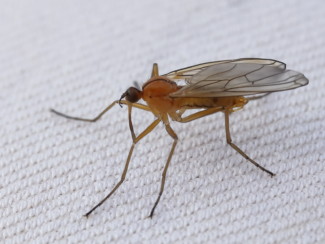One would think that a jacket and trousers would provide adequate protection from mosquitoes. And clothes do furnish a decent defense against the nefarious bloodsuckers.
But anyone who has spent time in the woods can assure you that clothes aren’t always enough to shield you from mosquito bites. It can be surprising when on the receiving end of a bite through thick denim jeans or socks. How is it possible?
Mosquitoes have special tools that can slice through clothes
Mosquitos have a unique mouthpart, called a proboscis, that can pierce right through clothes and woven fabric. The proboscis is a flexible, tubelike apparatus emanating from the mouth (see photo).
The length, flexibility, and needle-like shape of the proboscis lends itself to slicing through clothing and soft material with ease.
The mosquito proboscis has no less than six needles, each performing various functions when it bites. Two of the needles are called mandibles, which pry apart the skin, making it easier to for two other needles, called maxillae, to cut and saw into the skin. The maxillae are efficient and like drill bits. Pretty scary.
Another needle, called the labrum, acts as a straw for the mosquito suck your blood. If interested, here you can watch a super-cool high resolution video of the of the entire process of a mosquito bite.
With this assortment of specialized tools at its disposal, it’s no wonder mosquitoes can bite through clothes.
Which fabrics offer the most protection from mosquitoes?
How much resistance to mosquito bites does clothing afford? It depends.
Tightly-worn clothes like jeans, socks, and sweaters actually provide less defense than loose clothes. This may be counterintuitive. One would expect the thickness and heaviness of these garments to be more of a barrier to mosquitoes.
However, when clothes are tightly-worn, the skin is kept within striking distance of the long proboscis. Tight jeans make it difficult, but not impossible, for a mosquito to bite through. A loosely worn jacket, on the other hand, keeps the mosquito at adequate length from bare skin.
Clothes made with thick, tightly-woven fabric provide the best protection from mosquitoes. Synthetic, loosely-worn fabric is particularly effective.
Mosquito spray on clothes
Spraying clothes with mosquito repellant is another weapon you can use to protect yourself. Especially recommended if you plan to spend time in a mosquito infested area. Applying mosquito repellant directly to fabric provides optimal protection.
To do this, first test the mosquito spray on a small, discreet part of fabric. You want to be sure it will not stain your clothing. The underside of the garment is great for this. This way, if it does stain, it won’t be visible unless you wear the garment inside-out.
Thankfully, there are mosquito repellents designed for this very purpose. Created specifically for application directly to apparel, mosquito spray for clothes should not blemish or splotch your clothes.
How does a mosquito find a victim?
Mosquitoes have proteins and chemical receptors on their proboscis. From a distance, mosquitoes detect carbon dioxide emitted from the breath of potential blood-meals, and move in.
Once closer, receptors on the end of the labrum pick up on chemicals in the blood. Mosquitoes can distinguish the level of blood sugar, the sex of the target, and many other identifiers. Scientists believe that mosquitoes decide who and when to bite based on a complex algorithm of such signals, as yet to be fully understood.
Conclusion
Most of the time, wearing clothes is enough to protect from mosquito bites. Exposed skin provides the path of least resistance, after all. But the amazing anatomy of the mosquito makes it still possible to get bitten right through your clothes.
Applying mosquito spray directly to clothes is a good idea. This provides another layer of protection from mosquito bites.
For further reading, please check out my article on how long mosquito bites itch and learn how to make them go away quicker.
Get Rid of Pesky Mosquitoes
 |  |  |  |
| Handheld Mosquito Zappers | Mosquito Sprays | Ultrasonic Mosquito Repellers | Electric Mosquito Zappers |
Photo credit: “Empis stercorea (Empididae) – dagger fly/ Rotbraune Tanzfliege” by gbohne is licensed under CC BY-SA



Leave a Reply